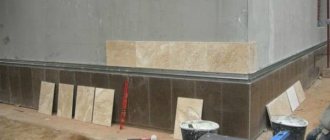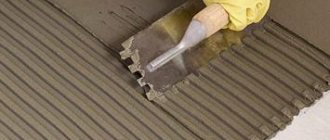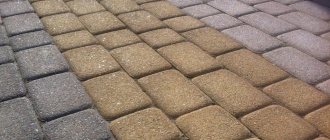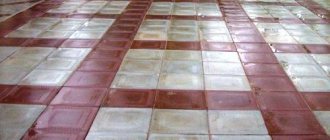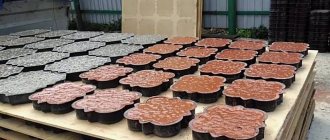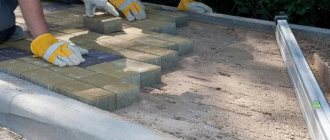Laying foam blocks with glue
Many people think about whether it is possible to put foam blocks on tile adhesive during construction and renovation. And the answer to this question will be positive. Of course it is possible, but before doing this you need to think about how justified such a step will be.
We will tell you below how to lay foam blocks on glue, in what cases it will be beneficial and how to do it. You can also get additional necessary information from the video in this article and photos.
How to lay tiles on aerated concrete blocks and foam blocks?
Dust removal and priming
It was important to thoroughly dust the base of the blocks with a vacuum cleaner and prime 2-3 layers with a good primer.
In your case, special attention had to be paid to this, since the gas block strongly absorbs moisture. There is a possibility that due to the small amount of primer, the moisture from the glue went into the wall too quickly and the glue did not have time to gain strength.
Leveling + primer
It was necessary to first level the walls with high-strength tile adhesive of at least class C1, rubbing it into the base, using reinforcing fiberglass or nylon mesh.
Gas blocks
Usage
In construction, aerated blocks are often used to build walls. They are very durable and resistant to external influences, they are not afraid of moisture and temperature changes. As a rule, such material is laid with special solutions and adhesives, but increasingly craftsmen use tile adhesive for installation.
With the help of gas blocks you can easily build a strong wall, partition, garage or barbecue area. Since the blocks are small in size and weight, repair work can be carried out alone without the involvement of third-party craftsmen.
Tools
Previously, classic spatulas were used to lay aerated concrete; a comb was also used when working with tile adhesive. It made it possible to apply the solution to the base and block as evenly as possible, due to which the consumption of the mixture was minimal.
Today, manufacturers offer a more modern device called a carriage. It allows you to control the thickness of the adhesive layer. Otherwise, the tool is called a trowel-bucket. Ultimately, the cost of all work is reduced, and the process goes faster.
Marking
Before the master begins laying aerated concrete, he always makes markings. It is especially important to do this when we are talking about a complex foundation. It must be applied strictly along the axes. During the work, the specialist lays out the blocks in a row to fit them into one line.
The size is adjusted, usually using a saw or a hacksaw for stone. It is extremely important to ensure that all elements are perfectly smooth and even. Also at this stage, holes are made in the thickness of the blocks - grooves; in the future, metal reinforcement will be fixed in them.
Is it possible to save the tiles?
If there was cement grout, this would be easier to do. And then, you need to look at how well the tile adhesive adheres to the porcelain tiles. Where was the gap? Where is the junction of the glue and the wall or where is the glue and the tile.
If the gap is near the wall, and the glue is firmly attached to the tile, then it will take a lot of time and effort to remove the glue from the tile. Is the tile glossy?
- Yes, glossy.
- In this case, there is also a high risk that during cleaning, adhesive from the tiles (this will need to be done with a grinder and a diamond tortoise), scratches may appear on the gloss.
You can't clean epoxy grout that easily. Alternatively, you need to warm it up with a hair dryer and when it softens, carefully cut it off with a utility knife. You can also heat it with a steam generator, but most likely you don’t have one.
As a result, I can only advise one thing - since tiles are very expensive, it will be more profitable for you to hire good specialists who have encountered a similar problem, so that they try to preserve the tiles. So that you don’t forget anything, I will post our dialogue in a separate publication and give you a link.
A few words about choice
How to choose the best adhesive mixture
Despite the fact that all adhesive compositions consist of almost the same components, their characteristics are often different. Therefore, when choosing, pay attention to the following parameters:
- Strength . The compressive strength of high-quality glue after 28 days is 6-7 MPa. For external load-bearing walls, it is advisable not to use compounds with a strength of less than 5 MPa;
- Adhesion . Must be at least 0.2 MPa. It is advisable to use compounds with adhesion of 0.5-0.6 MPa;
An important parameter is the time during which masonry adhesive can be used
- Time to use the solution . As a rule, the solution can be used within 120 minutes after preparation;
- Frost resistance . The optimal value is 40-50 cycles.
It must be said that some manufacturers add perlite to the composition, which increases the thermal insulation properties of the glue. True, if you insulate the walls, for example, with mineral wool, the presence of perlite in the glue will not affect the thermal insulation properties of the walls.
It is better not to insulate walls made of cellular concrete with materials that do not allow moisture to pass through. These include polystyrene foam, penoplex, polyurethane foam, etc.
Well-known manufacturers of mounting adhesive
Unfortunately, adhesive mixtures do not always correspond to the characteristics that manufacturers indicate on the package. Therefore, I will list the manufacturers who produce high-quality masonry adhesive for aerated concrete blocks:
| Brand | Peculiarities |
| Ceresit. This is a German brand owned by Henkel, whose history goes back more than 100 years. During this time, he became famous all over the world, and does not really need any introduction. Like other Ceresit products, the adhesive for aerated blocks does not cause any complaints. | |
| Kreisel. This is another German company that gained fame in the last century and has its production facilities in many countries around the world. Kreisel adhesive can be used for laying interior and exterior walls, as well as for rough surface finishing. | |
| Volma. A domestic manufacturer whose products are not inferior to foreign analogues. In particular, the glue has excellent characteristics and its price is quite affordable. | |
| Found. A young Russian company that, in just over 10 years, has managed to become one of the leaders in the domestic building mixtures market. This is due to the excellent price-quality ratio of products, including adhesive mixtures. | |
| Bergauf. Another German brand that is well known all over the world. The peculiarity of Bergauf glue is that it can be laid at temperatures down to -50 degrees. |
There are also other manufacturers who produce high-quality compounds. To avoid making a mistake with your choice, be sure to check for a certificate of conformity. In addition, purchase mixtures in large stores that have equipped warehouses. The fact is that storage conditions greatly affect the properties of the glue.
How to calculate quantity
Calculating the required amount of glue is not difficult. Basically, all you need to do is count the number of cubes of blocks. One cube of block requires approximately 25 kg of glue, i.e. one bag.
A bag of glue is required to lay a cube of blocks
Depending on the brand of the block and the glue itself, the consumption may vary. The manufacturer usually provides more accurate information on the packaging.
FAQ
Is it possible to lay tiles on aerated concrete walls?
As you already understood from the publication, of course you can, it is only important to follow the recommendations given in this publication
Do I need a mesh under the tiles on the foam block?
In principle, the mesh is usually made when there is either a thick layer of plaster (more than 30 mm) or where there will be puttying and painting (to avoid cracks). But if you do it with a margin of strength, then I think it’s better to do it with a mesh.
Porcelain tiles cracked on a foam block wall - what could be causing this?
There can be many options. For example, due to the fact that shrinkage occurred in the house and the wall became deformed. This could also be due to the fact that there was a void under the large-format tiles, and of course the reasons that are described in this publication.
What is glue - composition and types
Adhesive for aerated concrete consists of the following components:
- Portland cement;
- Mineral fillers;
- Organic modifiers;
- Polymer additives.
As you can see, the glue is also cement-based, but thanks to modifying additives and fillers, its properties are very different from ordinary cement-sand mortar.
Glue allows you to do masonry in winter
I note that all existing adhesives are divided into two types:
- Summer . Designed to perform work at temperatures above 5 degrees;
- Winter . Can be used at temperatures down to -15 degrees and below.
Why glue and not mortar - the advantages of a thin seam
First of all, I note that glue can only be used for autoclave blocks that have precise geometry. It is not worth using glue for non-autoclaved foam concrete, since it cannot be applied in a thick layer, and when applied thinly, cracks will form.
As for the autoclaved aerated concrete or gas silicate block, the use of a special adhesive solution when laying it provides a number of advantages:
- Reducing cold bridges . The solution between the blocks has high thermal conductivity, since it does not have air-filled cells, like foam concrete. Therefore, the narrower the seam, the smaller the cold bridges, and accordingly, the warmer the housing;
- Strengthening . The seams in any masonry are the least durable areas of the wall. Therefore, reducing the thickness of the seam increases its load-bearing capacity;
- Good adhesion . The glue has better adhesion to the blocks than regular mortar. This also improves the strength of the masonry;
- Increases the speed of wall construction . During the process of building walls, you have to be distracted much less often by preparing the mortar. In addition, the glue is applied faster than the solution;
The only downside is that the glue can only be applied in a thin layer. As I already said, this limits its scope. In particular, glue is not usually used for the first row of blocks.
Laying tiles indoors
Ceramic tiles are used for interior work; they are mainly used for finishing in rooms with high humidity, such as a bathroom, toilet or kitchen.
But ceramic products are not only a practical way to protect walls made of foam blocks, but also a way to add zest to the interior of any room. Manufacturers every year create new collections of tiles and tile mosaics that can satisfy every taste.
Glue selection
When choosing an adhesive solution for installation, an important point is the location of the work and the type of tile.
When laying in dry rooms, you can use the simplest types of glue, for example, cement-sand mortar, but when working in the bathroom it is important to use glue that is resistant to water and dampness.
It is also worth paying attention to the elasticity of the solution. The higher this indicator, the stronger the finished surface.
Depending on the type of tile, the color of the adhesive is selected. If the products are large, color does not play a special role, but if mosaics are used, you should give preference to a solution based on white cement. It does not have a pronounced shade and is not noticeable under the details of the mosaic, this is especially important when the mosaic has a translucent surface.
How to lay foam blocks with glue
Laying foam blocks with glue
Many people think about whether it is possible to put foam blocks on tile adhesive during construction and renovation. And the answer to this question will be positive. Of course it is possible, but before doing this you need to think about how justified such a step will be.
We will tell you below how to lay foam blocks on glue, in what cases it will be beneficial and how to do it. You can also get additional necessary information from the video in this article and photos.
What primer should I use for aerated concrete?
Universal primer option for aerated concrete
The Petromix product range includes modern environmentally friendly primers for aerated concrete
, suitable for external and internal work: deep penetration primer PL-01 - ready-to-use solution,
primer
PL-02 - diluted with water in a ratio of 1:5.
Interesting materials:
What is Knox protection? What is encrypting data? What is zr17? What is zoom in Russian? What will the subscriber hear if he is blocked? Cookie what is it? Where is Cookie Opera? Where are cookies in Chrome? Sofa or bed, which is better to choose? Accessories for front doors - what are they?
Preparation of the solution
The cement-sand mortar should have the most uniform consistency, so to prepare it, it is advisable to use a concrete mixer, into which you need to pour a bucket of water, fill a bucket of M500 cement and add three buckets of sifted sand .
Manual mixing of the solution is also acceptable.
During the mixing process, you need to add water in small portions, which will bring the mixture to the required consistency. It is recommended to add a water-retaining additive to the solution to prevent rapid absorption of moisture into aerated concrete.
Wall cladding made of foam blocks
Foam concrete surfaces require additional protection, since it has a loose structure and is not resistant to mechanical stress. For wall cladding, you can use different types.
The most suitable are:
- External finishing with brick or decorative stone;
- Installation of a ventilated facade;
- Using plaster.
Attention: It is more reasonable to provide for finishing the facade of a house made of foam blocks with brick or finishing stone during the design, since such finishing significantly makes the structure heavier and requires a stronger foundation that can withstand additional load. When cladding a building, it is not recommended to lay bricks close to a wall made of foam concrete blocks. The distance between them will protect the walls from condensation.
- The optimal solution for protecting walls made of foam concrete is the installation of a ventilated facade. The facing material can be different, the main thing is that it is attached to the wall on a wooden frame. On a wooden sheathing, unlike a metal one, moisture will not collect; it will evaporate due to the ventilated space between the wall and the cladding.
- To finish the surface with plaster, taking into account the internal structure of foam concrete, mixtures that allow water to pass through well should be used to avoid the accumulation of moisture inside the blocks. Before starting plastering work, you should clean the walls, then apply a primer to them. An obligatory step in the external decoration of walls is strengthening the metal reinforcing mesh, onto which the first layer of plaster mixture is applied. After it has dried, the surface must be primed again and allowed to dry. Only then are the walls covered with the finishing layer.
You now know how to put foam blocks on glue. You will choose for yourself whether the foam blocks are placed on cement or glue based on the volume of work.
Everything can be done with your own hands and construction costs will be reduced. The instructions will help you do everything efficiently and correctly.
What are foam blocks
Foam concrete is identical in composition to ordinary concrete. Its unique properties are provided by its porous structure, which is how it got its name. Foam blocks are a material product intended for external and internal construction work.
- Strength – comparable to the strength of monolithic concrete, although inferior in durability and rigidity. Foam blocks are quite fragile, so care must be taken when transporting and unloading.
- Thermal insulation properties are significantly higher than, for example, brick, but lower than those of specialized heat insulators - mineral wool or penoplex. However, material with low density and high porosity is readily used for thermal insulation of buildings.
- Lightness - a foam block measuring 200*300*600 mm weighs only 22 kg. Obviously, constructing a building from such a lightweight material will take much less time and require a simpler foundation.
- Ease of processing - blocks can be easily sawed, trimmed, drilled, and so on. Constructing arches or other curved elements from them is much simpler work than using bricks.
It should be remembered that foam concrete of different densities is used for different tasks:
- product with a density of up to 500 kg/sq. m. has increased thermal insulation properties;
- with a density from 500 to 900 kg/sq. m can be used in the construction of supports and load-bearing walls in cases where thermal insulation properties are also desirable;
- with a density of up to 1200 kg/sq. m, is used as a full-fledged construction material. Thermal insulation properties are reduced.
A few words about finishing
Finished walls can be plastered from the inside with tile adhesive or the same one you used for masonry. The layer of plaster in this case should be 5-7 millimeters. During the finishing process, it is necessary to glue the reinforcing mesh. Therefore, the glue is applied to the surface in two layers - a mesh is glued to the first fresh layer, and after it dries, a second, leveling layer is applied.
In most cases, it makes no sense to use plasterboard and other sheet materials for finishing, since the walls of their aerated blocks are smooth. Absolutely any materials can be used as a finishing coating - wallpaper, tiles, decorative plaster, plastic panels, etc.
As for exterior finishing, the best option is siding with preliminary insulation with mineral wool using the “ventilated facade” technology. You can learn more about the process of finishing foam concrete from other articles on our portal.
Now you know why to use glue, how to choose and use it correctly. I recommend additionally watching the video of the foam block laying process. If you have any questions while working, write them in the comments, and I will be happy to answer.
Is it possible to put gas silicate on tile adhesive?
Next I have to build a house for myself this year, I have been decorating for a long time, but in terms of construction, my knowledge is not enough. The thought came to mind, what if you put gas silicate like a tile under a comb, use inexpensive glue, like “Yunis” yellow, otherwise it will be completely unprofitable. I think it will turn out very smooth and beautiful
which will significantly facilitate further construction. How much more expensive, or not, will this method cost, all + and -. Are there any nuances of such construction, how reliable is it? I'm waiting for your opinions.
evgeni86 wrote: I'm waiting for your opinions.
I'll start with this.
evgeni86 wrote: I have been decorating for a long time, but in terms of construction, my knowledge is not enough.
Therefore, I will say that when building partitions from blocks in apartments, I use exclusively tile adhesive. Since the quantities are not prohibitive, I use Unis Plus. It turns out great.
evgeni86, tile adhesive produces thin seams, which is important in terms of thermal insulation, it is important that the geometry of the gas silicate is good, otherwise it will be a pain to adjust the blocks. For dressing with facing masonry, we use flexible connections with a thickness of 4-5 mm, or they also recommend using a fiberglass mesh, but you need to be careful with it so that in the brick-gas silicate transition it is recessed into the mortar, otherwise it is just a rag and does not play any role.
It's better to do it forty times than never forty times. )))
Don’t forget to make a waterproofing layer between the base and the gas silicate. In general, protect the gas silicate from moisture. In “thin” places - the level of the floor slabs (see 10 below and see 10 above the slabs) inserts of 5 cm are made. EPS between the facing masonry and gas silicate. The density of gas silicate, in my amateurish opinion, is no less than 400.
It's better to do it forty times than never forty times. )))
Based on my limited experience, I can say that laying foam blocks with tile adhesive is much weaker than with the same notorious perflix
Maybe you meant perlfix? So it seems to be for interior work
It's better to do it forty times than never forty times. )))
Reason wrote: So it seems to be for interior work
Yes for internal ones, but the meaning of the statement
BARABAZ wrote: laying foam blocks with tile adhesive is much weaker
is that the blocks must be laid on the materials provided for this
BARABAZ wrote: the fact is that the blocks must be laid on the materials provided for this
BARABAZ wrote: laying foam blocks with tile adhesive is much weaker

